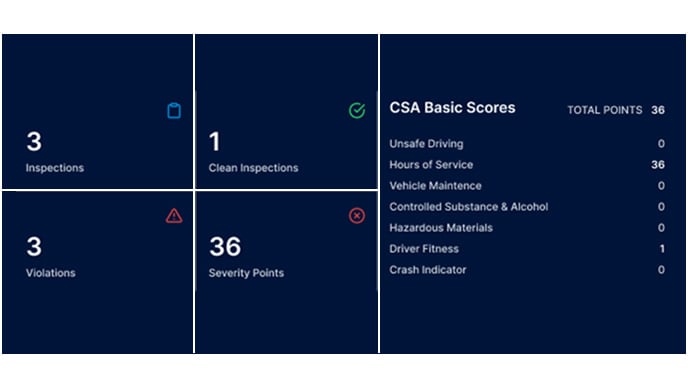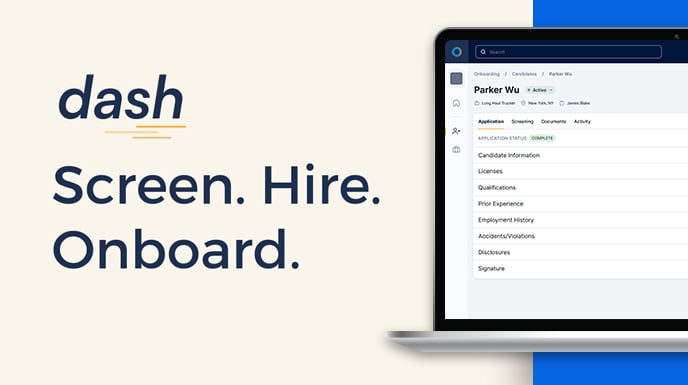Have questions about managing DOT compliance in your business? We have the answers. If you can’t find the answer you’re looking for, please contact us and one of our compliance specialists will be happy to assist you.
Registration & Operating Authority
You’ll need a US DOT Number if your company operates commercial motor vehicles that transport passengers or hauls cargo in interstate commerce, or if you are a commercial interstate or intrastate carrier who hauls hazardous materials in quantities that require placarding.
Certain states require all Commercial Motor Vehicle registrants to get a U.S. DOT Number. These include Alabama, Alaska, Arizona, Colorado, Connecticut, Florida, Georgia, Indiana, Iowa, Kansas, Kentucky, Maine, Maryland, Michigan, Minnesota, Missouri, Montana, New York, Nebraska, Ohio, Oklahoma, Oregon, Pennsylvania, South Carolina, Tennessee, Texas, Utah, Washington, West Virginia, Wisconsin, and Wyoming.
- Motor Common Carrier of Property except Household Goods
- Motor Contract Carrier of Property except Household Goods
- Motor Common Carrier of Household Goods
- Motor Contract Carrier of Household Goods
- Broker of Property except Household Goods
- Broker of Household Goods
- United States-Based Enterprise Owned or Controlled By Persons of Mexico Providing Truck Services For The Transportation of International Cargo (Except Household Goods)
- United States-Based Enterprise Owned or Controlled By Persons of Mexico Providing Truck Services For The Transportation of International Household Goods
- Freight Forwarder Authority
- Motor Passenger Carrier Authority
- Mexico-based Carriers for Motor Carrier Authority to Operate Beyond U.S. Municipalities and Commercial Zones on the U.S.-Mexico Border
- Mexican Certificate of Registration for Foreign Motor Carriers and Foreign Motor Private Carriers Under 49 U.S.C. 1302.
- Have a registered gross vehicle weight or actual weight or combination weight more than 26,000 pounds; or
- Are power units with three or more axles regardless of weight.
- Date of trip (starting and ending)
- Trip origin and destination
- Driver's name or signature
- Total trip distance
- Distance by jurisdiction
- Routes traveled and odometer readings (beginning and ending)
- Registrant's name
- Fleet number
- Unit number or VIN
- Plate number
DOT Safety Audit
- Most motor carriers will have to undergo the New Entrant Safety audit within 12 months of registering with the DOT.
- Passenger carriers must undergo the New Entrant Safety audit within 120 days of registering with the DOT.
If your safety audit is onsite, it will either occur at your primary business location, or at a local facility, such as a hotel or conference center, along with other New Entrants from the area.
If your safety audit is offsite, you will be required to upload specific documentation to the FMCSA portal, proving your compliance with federal regulations.
- Driver Qualifications
- Driver Duty Status/Hours-of-Service
- Vehicle Maintenance
- Accident Registers and Documentation
- Controlled Substances and Alcohol Use Testing
- Hazardous Materials Requirements
Just because you are not expecting an audit does not mean that that you won’t be hearing from the DOT. FMCSA, the DOT agency charged with ensuring motor carrier safety, conducts thousands of audits each year, and your turn may be right around the corner.
Our Audit Risk Monitor will help you get into compliance and maintain it on an ongoing basis. Our program will help improve your safety compliance, making your operation safer.
A Satisfactory safety rating means that a motor carrier has functioning safety management controls that are appropriate for the size and type of operation of the motor carrier.
A Conditional safety rating means a motor carrier does not have adequate safety management controls in place, and this could result in violations.
An Unsatisfactory safety rating means a motor carrier does not have adequate safety management controls in place to ensure compliance, and this has resulted in violations.
Fuel Tax
- Three or more axles regardless of weight, or
- Two axles with a gross vehicle weight over 26,000 pounds; or
- Used in combination with a total gross vehicle weight over 26,000 pounds
- Where its qualified motor vehicles are registered
- Where it maintains operational control and operational records of its qualified vehicles, and
- That qualified motor vehicles travel in
In most jurisdictions, motor carriers are required to file fuel tax returns with their IFTA jurisdiction office each quarter. To avoid penalties, IFTA returns, along with any payment for taxes due, must be postmarked on or before the deadlines listed below:
- Quarter 1: April 30
- Quarter 2: July 31
- Quarter 3: October 31
- Quarter 4: January 31
You must file a return even when no miles were traveled, or no taxable fuel was used during the quarter.
IFTA license holder, you are responsible for maintaining detailed distance and fuel purchase records for all qualified motor vehicles. Specifically, you must prepare:
- Detailed Trip Reports
- Monthly Fleet Summaries
IFTA Trip Reports must include:
- Date of trip (Start and End)
- Trip origin and destination
- Routes of travel
- Beginning and ending odometer reading
- Total trip distance
- Distance by jurisdiction
- Vehicle Identification Number
- Vehicle Fleet Number
- Registrant’s Name
The following states require certain commercial motor vehicles traveling through their states to pay a highway use tax:
- Connecticut has a Highway Use Tax (HUT) for vehicles weighing 26,000 pounds and above
- New York has a Highway Use Tax (HUT) for vehicles over 18,000 pounds
- Kentucky requires a Highway Use License (KYU) for vehicles with a gross weight of 60,000 pounds or more
- New Mexico has a Weight Distance Tax for vehicles over 26,000 pounds
- Oregon has a Highway Use Tax for vehicles over 26,000 pounds
FMCSA Hours of Service
Per 49 CFR 390.23 of the Federal Motor Carrier Safety Regulations (FMCSRs), certain safety regulations (49 CFR Parts 390-399) are temporarily lifted for those participating in relief efforts. In addition to the Part 395 Hours-of-Service rules, these regulations cover:
- General Federal Motor Carrier Safety Regulations (Part 390)
- Driver Qualifications (Part 391)
- Driving Commercial Motor Vehicles (Part 392)
- Parts and Accessories for Safe Operation (Part 393)
- Inspection, Repair and Maintenance (Part 396)
- Transportation of Hazardous Materials (Part 397)
- Transportation of Transportation Workers (Part 398)
- Employee Safety and Health Standards (Part 399)
Yes, the regulations allow you to use an Electronic Logging Device (ELD).
You do not need to use an ELD if any of the following applies to your business:
- You employ drivers who operate under the short-haul exceptions
- You employ drivers who use paper RODS for no more than eight days out of every 30-day period
- You employ drivers who conduct drive-away-tow-away operations, in which the vehicle being driven is the commodity being delivered
- You employ drivers of vehicles manufactured before 2000
DOT Drug & Alcohol Testing
- Any fatality (except for the driver).
- Citation for moving violation and disabling damage to any involved vehicle.
- Citation for moving violation and medical treatment away from the scene.
Is the individual driving now or is he out on worker’s comp or medical leave? If they are not presently working and available to perform safety-sensitive functions, they should not go for testing at this time. If the individual is driving, or available to drive, did the doctor who prescribed the medication know that he drives for a living? (The doctor may decide he shouldn’t drive while on the pain medication or may be able to prescribe something different that won’t affect their driving.)
Should the result come back positive, our MRO would call and discuss the result and your driver would state that they are on prescribed medication. An individual taking a medication prescribed to them, in the manner it is prescribed, shouldn’t have anything to worry about.
If you have a reasonable suspicion that a DOT-regulated safety-sensitive employee is using drugs, you are required to send them for a reasonable-suspicion drug test. Your determination to test must be based on specific, contemporaneous, articulable observations concerning the appearance, behavior, speech or body odors of the employee. The supervisor making the reasonable-suspicion determination must be trained in reasonable suspicion. The regulation specifies 60 minutes of alcohol and 60 minutes of controlled substances reasonable-suspicion training.
An individual cannot be “selected” for random testing at the request of an employer since this is not a scientifically valid method. Conducting a “random” test without documentation that shows how the individual was selected could put your company at risk for legal action.
Yes. If the authorization merely informs the employee that USDOT drug testing is not subject to the same privacy generally experienced in the Health Insurance Portability and Accountability Act HIPAA) of 1996, the authorization would not constitute a consent, release, waiver of liability, or indemnification under 49 CFR Part 40.355.
The failure of the employee to provide a urine sample or comply with the collection must be considered a refusal. Even if the authorization did violate 49 CFR Part 40.355, FTA would expect the employee to comply with the test. An item of non-compliance on the part of the collection site is handled by FTA or the transit agency/TPA, not the employee. An authorization, such as the one in question, should not be used in U.S. Department of Transportation (DOT) testing. The testing form itself is the only authorization required.
DOT Driver Qualification Files
Anyone driving a double/triple trailer or tanker vehicle needs to complete a road test and receive a Certificate of Road Test upon successful completion. If the individual will operate a vehicle that is not a double/triple trailer or tanker, the driver’s state-issued CDL will allow them to operate the specific category of Commercial Motor Vehicles designated on his or her license. In such an instance, the employer may accept a copy of the driver’s license in lieu of conducting a road test.
If a prospective employee has a valid Certificate of Road Test issued to them within the preceding three years, the employer may accept the document in lieu of performing its own road test.
Though not required, a road test is never a bad idea. Foley’s guidance is to always have prospective employees complete a road test.
.png)


